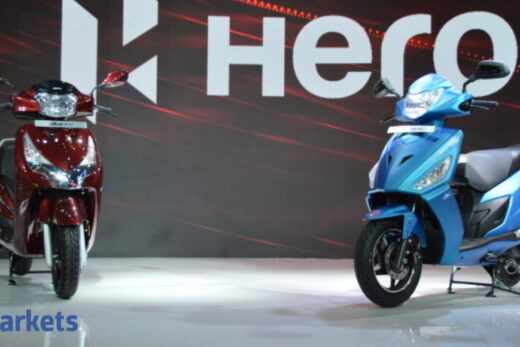You are hearing so much about EVs. You have Ola’s Bhavish Aggarwal saying he has sold one bike every four seconds. Is the market indeed opening up? With EVs, two wheelers are clearly the winner and four wheelers are lagging behind.
Yes indeed, the market exploded. I mean what we are finding is that the policies the government policies are to a great deal in place. They have been enhanced, earlier they had a policy and there has been correction done on that which is resulting in a very positive mood in the market.
There is a tremendous amount of demand which is coming in and at this point we are not able to cope with that kind of demand so we are lagging behind in terms of supplies. That said we are building up our capacities now. What is basically triggering this is one, of course, there are the government policies which are conducive for the sector. It is not just the centre but there are numerous state policies also which are helping push this sector forward.
The second is that there is growing awareness amongst the people. They are understanding the benefits of electric vehicles. Of course, there is also the factor of TCO or Total Cost of Ownership. The initial purchase price of electric was higher than IC engine vehicles but the running cost was multiple times lower. With petrol prices being where they are, the gap between the two has widened substantially, so electric vehicles have become cheaper to run and IC Engine vehicles have become far more expensive to run.
There are numerous such factors which are resulting in customers now opting for electric mobility far more than what they were earlier and I am glad to see competition coming in because that only grows the market. Very interesting and exciting times indeed.
Have you done any analysis of what this price gap right now is between the EVs and the IC vehicles? What kind of a delta are we talking about and is this why you are seeing large orders from corporates which is pushing sales? You have a Zomato, Swiggy, Flipkart, Amazon with deadlines for themselves as far as having EV fleets go. Is that where all of the orders are coming from?
Let me explain the economics to you. There are subsidies in place at central and state levels. City speed is usually about 45 to 55 odd km in vehicles which will give you a range of anything from 80 to 210 kms. These vehicles are now at about Rs 65,000 for most parts of the country and cheaper in states where they have additional subsidies like Delhi, Maharashtra, Gujarat, Rajasthan etc.
They are cheaper than IC engine commuter vehicles and that is one part of it. Now in states where you have additional subsidies, they become even cheaper because there are numerous state policies which are more manufacturing led. A number of states have gone the other way as well to say that while we support you from a manufacturing policy standpoint, we will also support in creating demand which is a very very important factor.
These two things have resulted in these vehicles becoming cheaper. The market where the demand is coming from is B to B, which is a very important sector and that B to B spans a very wide spectrum. There is of course, e-commerce goods, then you have food deliveries, smaller food deliveries and shared mobility. This sector we were nurturing for the past many years, so we have separate teams which work only on B to B. This sector is playing an important role but that is not where all of the demand is coming from.
The demand is coming more from the consumer standpoint. Because of subsidies coming into play and because of the support that we are getting, these vehicles have become even cheaper than low speed vehicles. The demand is shifting from low speed category towards city speed category. Now the minute you shift to the city speed category, you are now in the realm of the commuter segment which is a very large segment of the automobile industry.
The two wheelers cost about Rs 75,000 to 80,000 and people effectively use it to commute, so they are very price sensitive not just on the initial purchase price but also the running cost. They are not asking for speed but they do not want to be left behind, they want to be able to get on the traffic on the flyover without a problem, without really using too much speed and that is where the city speed category fits in. So it fits in brilliantly there.
In terms of running, it is multiple times cheaper than an IC engine vehicle. To give you the economics, if a person is using a vehicle for 50 km a day with the IC Engine, he is looking at 1 litre of fuel which is about Rs 100 per day. With the electric vehicle of ours which is a city speed category, you are looking at 1.5 units of power, which is about Rs 12. Multiply that over a span of three years or 1000 days, you are looking at Rs 1 lakh versus Rs 12,000. You get Rs 88,000 approximate savings in terms of the TCO. B to B always understood the concept of TCO very well, now consumers are also understanding it. That is why the market is shifting.
Whenever we speak with any of the market participants, they are still pretty apprehensive of investing into the EV theme and they still believe that there are lot of challenges. What are the hurdles that the industry per se is currently facing? Are there still question marks in terms of refinancing, resale value, charging infrastructure, etc, that you have been hearing?
I can tell you from my industry perspective so there are certain challenges, of course, which are there but those are not unbridgeable challenges. When you talk about electric mobility, you have different forms of vehicles in a different category – two wheelers, three wheelers, cars, public transport, commercial vehicles. All of them will take off at a different time and all of them have different needs and requirements in terms of the infrastructure, the charging, pricing etc. And the pricing, of course, differential between IC and electric.
Now two wheelers are low-hanging fruit because the gap between the purchase price has reduced substantially. Now the challenges which exist in this sector, one is the charging infrastructure. We are bridging that by installing our own charging infrastructure. We have installed about 1650 charging stations for customers in dense markets.
What we have done is make our batteries portable, so even if you are in a city or in a block of apartments where you do not have charging infrastructure, you can effectively take the battery up to your apartment, charge it there, plug it back into the vehicle and off you go. And we can offer you a range of anything from 80 kilometres upwards to 210 kilometres in the same vehicle using modules of that same battery.
Financing has been a challenge to start with because till last year the majority of vehicles were unregistered, they were low speed category vehicles, so financing was a bit of a challenge. Even though we have numerous relationships with NBFCs and banks but we are finding since then there is a change that has happened in the policies. Now the market is shifting to the city speed category.
As an industry there are challenges or there are issues like batteries still not getting manufactured in India, the cells are still not getting manufactured but that is a matter of economics. Once we get to a certain scale and I believe there are numerous companies who have already shown interest in the government PLI of 18,100 crores for ACC, or the advanced cell chemistry battery manufacturing in India. I believe that is only a matter of time, in a matter of a year or two years, we will see batteries being manufactured, cells being manufactured in India. They are already being assembled here.
There are no such huge challenges which are there at this point which would result in this industry not really taking off. These are all bridgeable challenges. There are two-three factors which are required. One is creation of more awareness. When we talk about environmental concerns, air pollution is another important factor which we as a government, as people, as companies, should be talking about. We should be talking about how to do we bridge air pollution.
So last year we have done numerous programmes. We continue to do numerous programmes where we talk about solutions for air problem because that is a huge problem not just in urban but even rural areas in India. We are one of the most polluted cities in the world. We have to convert to zero emission vehicles ASAP, I mean we cannot afford to wait for too long.
The second factor is that we need to set ourselves long-term goals. There could be different goals for two wheelers, different for larger vehicles and different for commercial vehicles, etc, but there should be goals which are highly achievable. Once we set those goals in place then in backward calculation infrastructure, your supply chains, your dealer networks, your financing everything will begin to fall into place because we now have a deadline by which we have to convert. That deadline like I said should not be too far. I believe a six-year deadline from now is actually a very good deadline for two wheelers to start converting to electric.
How Ola is selling their bikes as hotcakes? I wanted to understand what your own internal sales targets are for the financial year and the revenue as well, the numbers that you are working with?
What we have done is that we have upped our target. In the last number of years, we have only been increasing our targets year-on-year for the next following year, including this year. This year we are going to be at about a 100000 odd units but we are gearing up for half a million units for the next year so that is where the capacity enhancements are happening, our supply chains are being built up accordingly, our dealer network is being expanded accordingly and the marketing spends and marketing work that we are doing is again in sync with all of that.
Now what we are going to be doing is while we build to about a half a million next year, we are going to add a million units every year, year-on-year for the next couple of years because we would like to keep our eye on the market as well.
What we believe is in the commuter segment and in an entry level segment where a person is buying a vehicle for about 70000-75000 rupees, he is going to look at a price point which is very similar to the band that he is already operating in because he does not necessarily have the wherewithal to really go out and buy a vehicle at a much higher or double the price.
He may be saving from a total cost of ownership over a period of time but so he would set initial purchase price as being a very-very important factor. So we look at that kind of a price point. What we anticipate is that by next year we would be at about a half a million and then adding on about a million units thereafter year-on-year and our supply chains are being geared up to handle much larger volumes.



